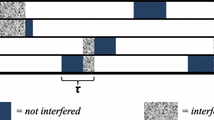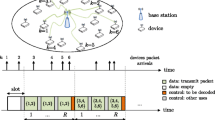Abstract
In this paper, the capture performance of a random access scheme in the presence of Rayleigh fading, shadowing and diversity is studied. The conditional throughput Cn, i.e., the average number of packets which are correctly received per slot, given the number of colliding packets, n, is computed, as well as its limit as n⊒∞. Some different diversity schemes are compared. Also, retransmission control is considered as a means to enhance the system performance. The stability of the controlled system is directly proved. Finally, the effect of long-term attenuations on the system performance and stability is discussed.
Similar content being viewed by others
References
N. Abramson, The throughput of packet broadcasting channels, IEEE Transactions on Communications 25 (January1977) 117–128.
J.C. Arnbak and W. van Blitterswijk, Capacity of slotted ALOHA in Rayleigh-fading channels, IEEE Journalon Selected Areas in Communications 5 (February 1987) 261–269.
D. Bertsekas and R. Gallager, Data Networks(Prentice-Hall, Englewood Cliffs, NJ, 1992).
S. Ghez, S. Verdu and S.C. Schwartz, Stability properties of slotted ALOHA withmultipacket reception capability, IEEE Transactions on Automatic Control 33 (July 1988) 640–649.
D.J. Goodman and A.A.M. Saleh, The near/far effect in local ALOHA radio communications, IEEE Transactions on Vehicular Technology 36 (February 1987) 19–27.
I.S. Gradshteyn and I.M. Ryzhik, Table of Integrals, Series and Products (Academic Press, New York,1965).
I.M.I. Habbab, M. Kavehrad and C.-E.W. Sundberg, ALOHA with capture over slow and fast fading radio channels with codingand diversity, IEEE Journal on Selected Areas in Communications 7 (January 1989) 79–88.
B. Hajek, A. Krishna and R.O. Lamaire, On the capture probability for a large number of stations, IEEE Transactions on Communications 45 (February 1997) 254–60.
B. Hajek and T. van Loon, Decentralized dynamic control of a multiaccess broadcast channel, IEEE Transactions onAutomatic Control 27 (June 1982) 559–569.
W.C. Jakes, Microwave Mobile Communications (Wiley, New York,1974).
L. Kleinrock and S.S. Lam, Packet switching in a multiaccess broadcast channel: performance evaluation, IEEETransactions on Communications 23 (April 1975) 410–423.
K.S. Kwak, Interacting random access communicationnetworks, Ph.D. dissertation, University of California, San Diego, CA (1988).
K.S. Kwak and R.R. Rao, Controlled ALOHAwith geometric capture probabilities, IEEE Transactions on Automatic Control 35 (November 1990) 1270–1274.
R.O. LaMaire and M. Zorzi, The effect of correlation in diversity systems with Rayleigh fading, shadowing, and power capture, IEEEJournal on Selected Areas in Communications 14 (April 1996) 449–460.
C.T. Lau and C. Leung, Capture models formobile packet radio networks, IEEE Transactions on Communications 40 (May 1992) 917–925.
J.P.M. Linnartz,Narrowband Land-Mobile Radio Networks (Artech House, 1993).
J.J. Metzner, On improving utilization in ALOHA networks,IEEE Transactions on Communications 24 (April 1976) 447–448.
V.A. Mikhailov, Geometric analysis of the stability ofMarkov chains in R n+ , and its application to throughput evaluation of the adaptive random access algorithm, Problemy Peredachi Informatsii 24 (January-March 1988) 61–73. Translated in Problems of Information Transmission (July 1988).
C. Namislo, Analysis ofmobile radio slotted ALOHA networks, IEEE Journal on Selected Areas in Communications 2 (August 1984) 199–204.
L.G. Roberts, ALOHA packet system with and without slots and capture, Comput. Commun. Review 5 (April 1975) 28–42.
A.U.H. Sheikh, Y.D. Yao and X.P. Wu, The ALOHA systems in shadowed mobile radio channels with slow or fast fading, IEEETransactions on Vehicular Technology 39 (November 1990) 289–298.
A. Shwartz and M. Sidi, Erasure, capture, and noiseerrors in controlled multiple-access networks, IEEE Transactions on Communications 37 (November 1989) 1228–1231.
C. Vanderplas and J.P.M. Linnartz, Stability of mobile slotted ALOHA network with Rayleigh fading, shadowing and near-far Effect,IEEE Transactions on Vehicular Technology 39 (November 1990) 359–366.
V. Wong and C. Leung, Capture probabilityin a mobile packet radio system, IEEE Transactions on Communications 40 (October 1992) 1577–1580.
M. Zorzi,Mobile radio slotted ALOHA with capture and diversity, Wireless Networks 1 (May 1995) 227–239.
M. Zorzi and R.R. Rao, Slotted ALOHA with capture in mobile radio environment, in: Proc. International Zurich Seminar’ 94 (March 1994) pp. 391–399.
M. Zorzi and R.R. Rao, Capture and retransmission control in mobile radio, IEEE Journal on Selected Areas inCommunications 12 (October 1994) 1289–1298.
Author information
Authors and Affiliations
Rights and permissions
About this article
Cite this article
Zorzi, M. Mobile radio slotted ALOHA with capture, diversity and retransmission control in the presence of shadowing. Wireless Networks 4, 379–388 (1998). https://doi.org/10.1023/A:1019129012116
Issue Date:
DOI: https://doi.org/10.1023/A:1019129012116




